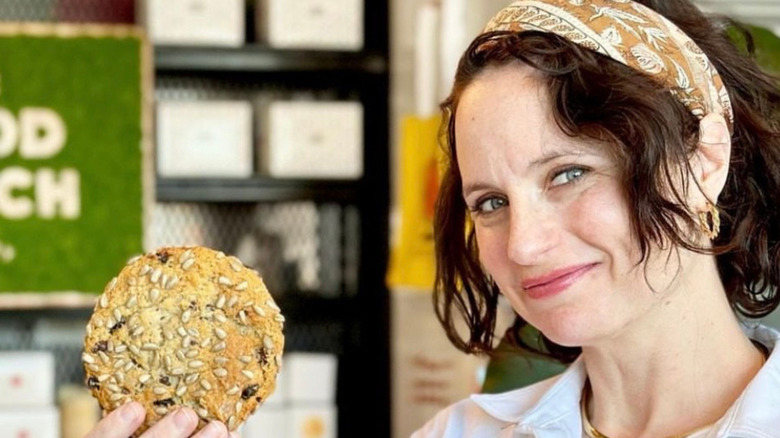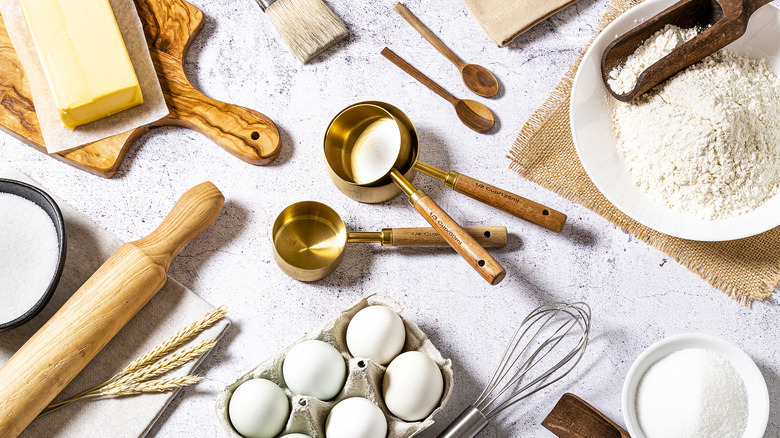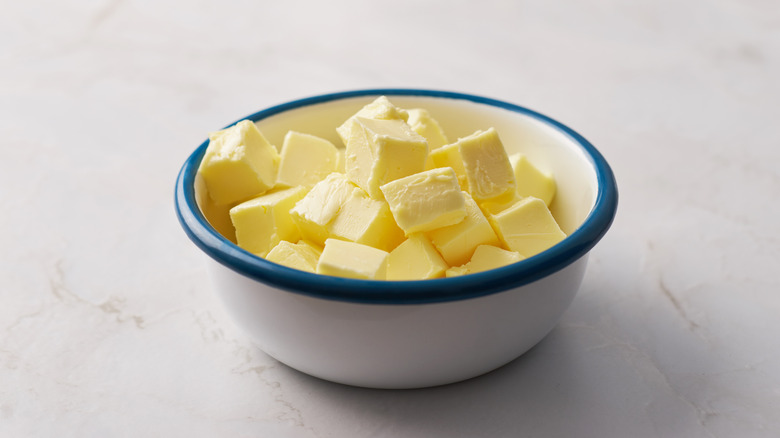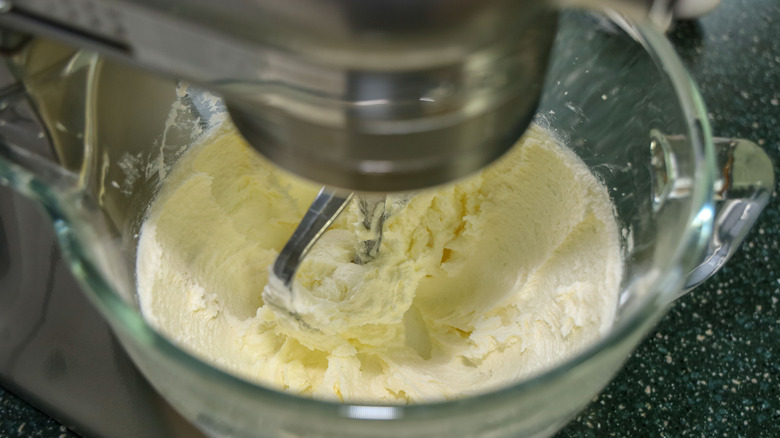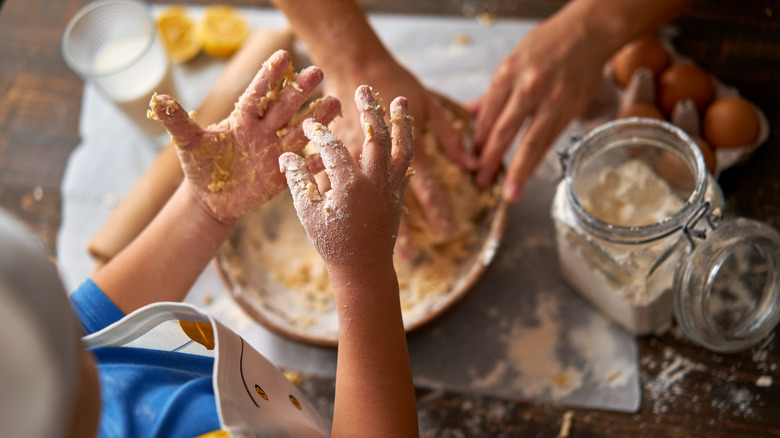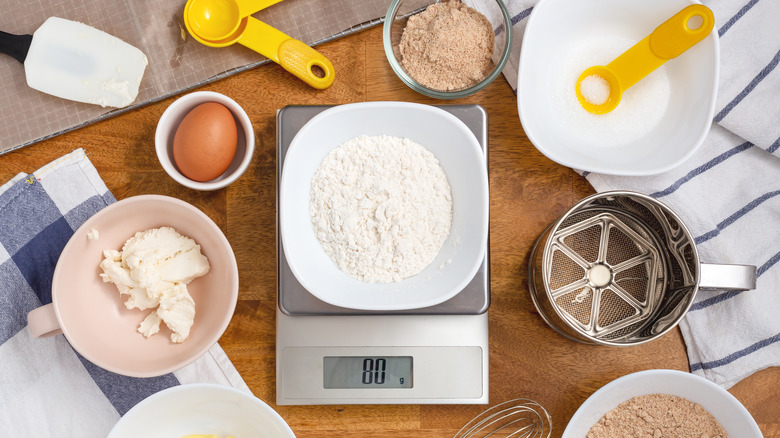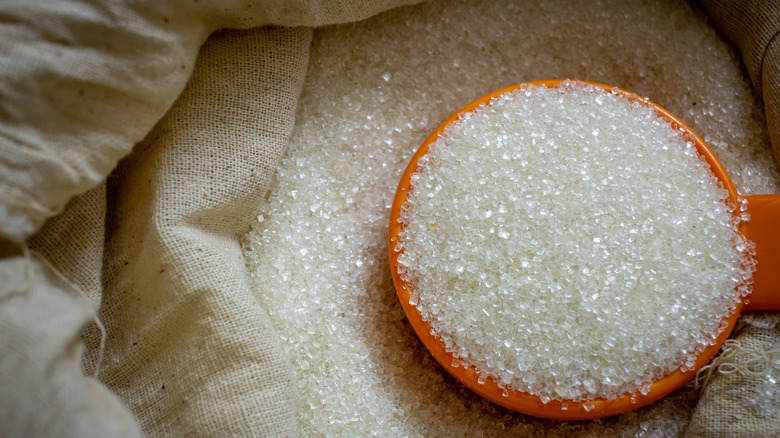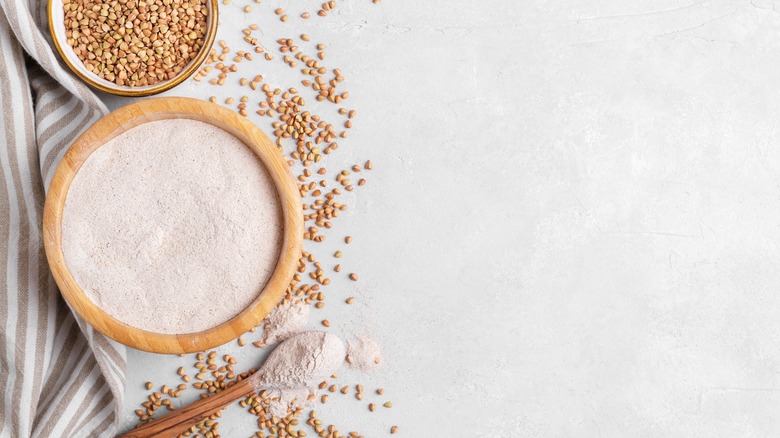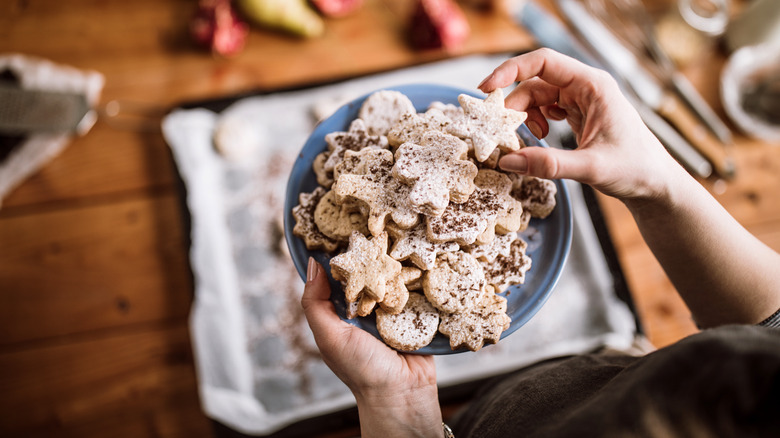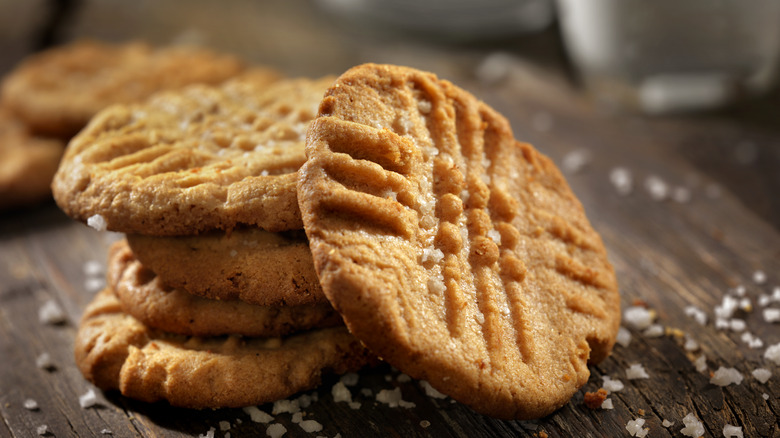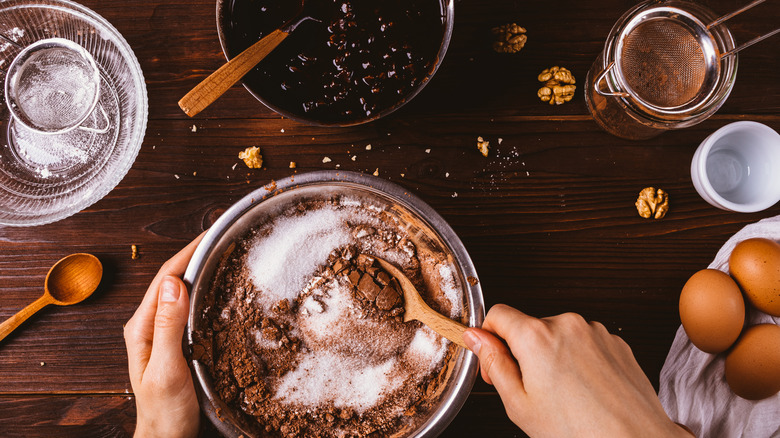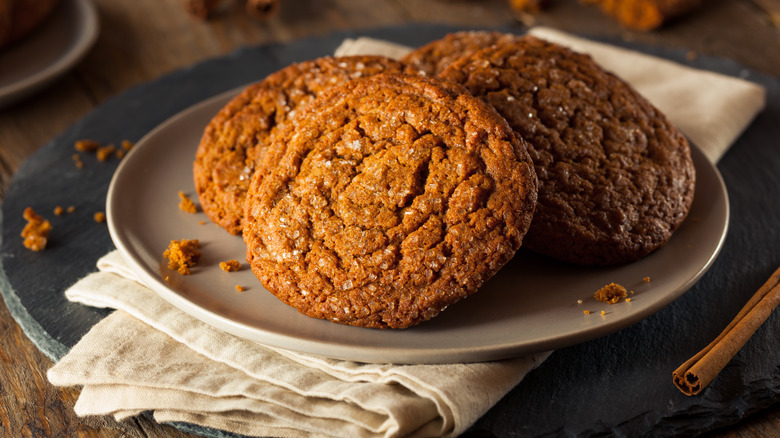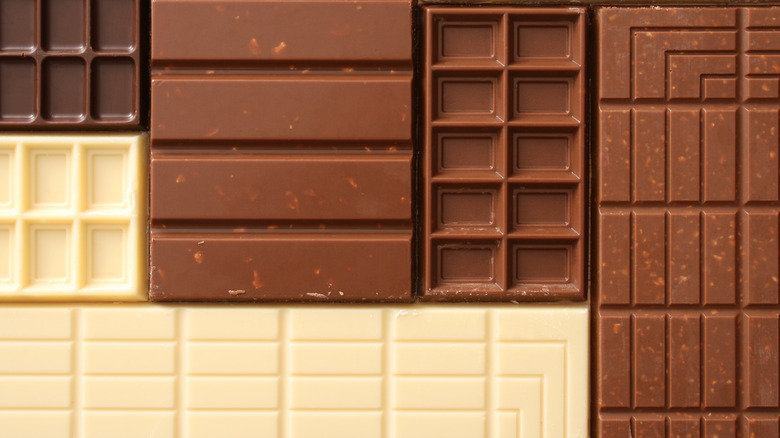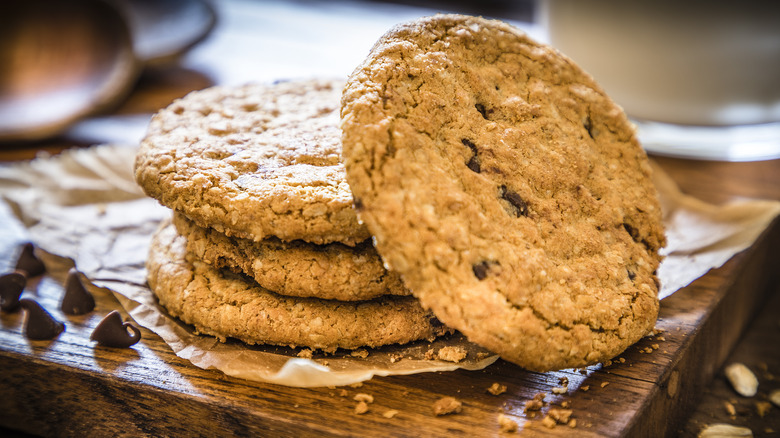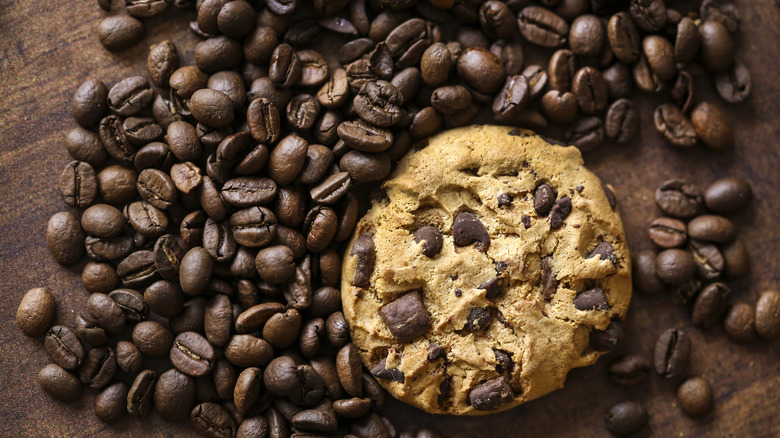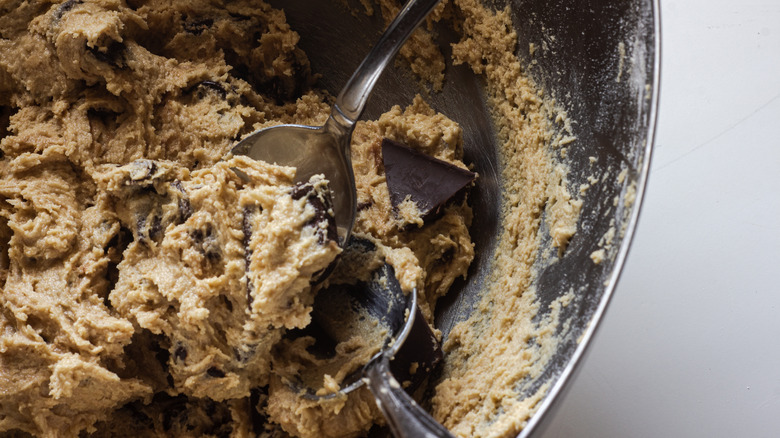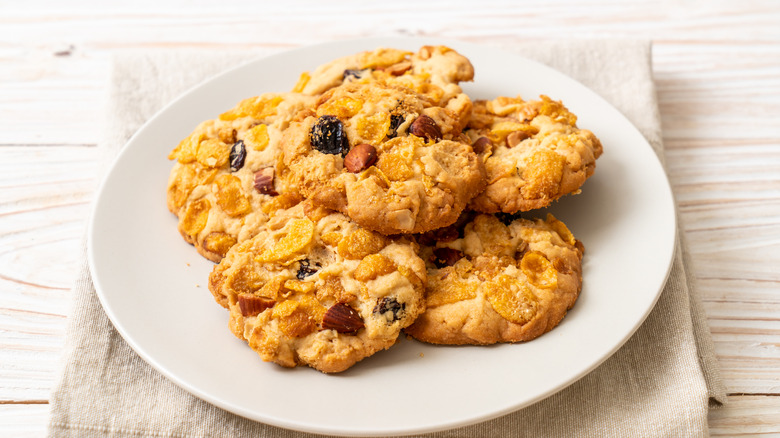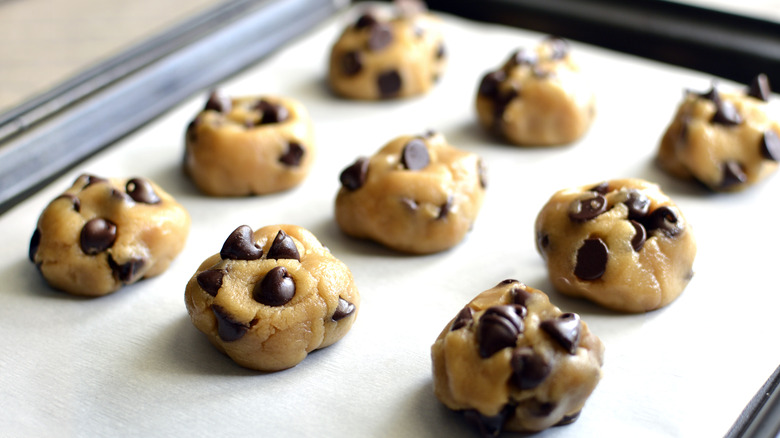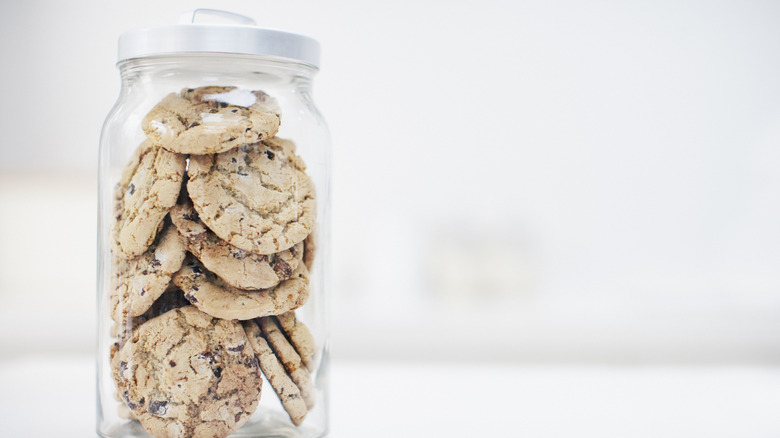19 Ways To Elevate Homemade Cookies, According To The Good Batch's Anna Gordon
Crafting and baking the perfect cookie is both an art and a science. And no one knows that better than Anna Gordon, founder of New York City's The Good Batch. She used her training from her years of education at the Institute of Culinary Education and her experience as a member of the James Beard Foundation Women's Entrepreneurial Leadership (WEL) fellowship program to craft innovative and flavor-forward cookies for her customers. Her bakery, located in Brooklyn, offers world-class cookie flavors with an emphasis on savory-sweet flavors, locally-sourced produce, and the classic cookie experience — with a few surprise twists, of course.
We had the opportunity to talk about everything cookie with Anna Gordon, from the methodology of cookie baking to exceptional ingredients that can make a bland cookie into something truly extraordinary. Here are some of her best tips for home cooks to make stellar homemade cookies bound to impress any cookie enthusiast.
Read your recipe and prepare your kitchen for baking
Any chef can tell you the importance of a mise en place — a method of organizing and structuring your kitchen space for maximum efficiency. The same concept can be applied to making cookies. Anna Gordon recommends home cooks set up a mise en place of sorts prior to baking cookies. This includes always measuring ingredients before turning any machines on and reading your recipe to know if you're going to have to chill your dough in the freezer or refrigerator before baking. "I cannot overstate these kinds of things," she comments.
Reading your recipe and gathering your ingredients beforehand will also allow you to ensure that you have the right type and quantity of ingredients before your hand even touches a spatula. Since baking is very precise and substitutions are limited, being prepared will minimize the headaches on your end and help ensure your batch of cookies comes out as the recipe intended.
Always start with room temperature ingredients
Baking truly begins in the preparation steps. According to Anna Gordon, the key to a successful cookie recipe is always to ensure your ingredients are prepped and ready to go before you start baking. This includes bringing all your ingredients up to room temperature so they blend into the dough more seamlessly.
For example, she recommends pulling out your butter and leaving it on your countertop the night before you bake cookies. If the room's ambient temperature is warmer, such as during the summer months, she notes that you can take it out just a few hours before turning on your mixer. Her trick for testing if butter is the perfect temperature is to touch it with a finger. If an indent is left in the butter, it is perfect for creaming.
Be mindful to avoid under- or over-whipping
Anna Gordon notes that one of the most common mistakes made with baking cookies is either under-whipping or over-whipping the butter and the sugar together. This process, called creaming, is critical because it beats and traps air in the butter's fat structure. She notes that you should not be able to see the shape of the stiff butter in the cream (under-whipped) or wait until the mixture is pure white in color (over-whipped). "So, it's mixing it until it's like light yellow — that's the perfect place to stop," she shares.
The cookie's appearance after baking will also tell you if you adequately creamed the butter or not. "If you feel like you followed all the recipe, you did all the right ingredients, you measured correctly, but your cookies came out like super flat, how much you whipped your butter, eggs, and sugar can be a place you come back to." She notes that overwhipping tends to produce flat cookies, while underwhipping creates cookies without a defined shape.
Avoid gluten formation after adding the flour
Gluten is an important grouping of proteins that adds structure to baked goods. However, too much gluten can come to the detriment of your cookie, Anna Gordon points out. "Once your flour is into a cookie, unless the recipe says otherwise, I really stop mixing the beater as soon as all the floury bits have disappeared."
If Gordon is baking with inclusions, like chocolate chips or nuts, she'll manually add the ingredients to the bowl after the flour has been adequately combined. She notes that scraping down the bowl after the flour and extra ingredients have been added acts as a final stir and allows the baker to control how much the mixture has been handled, which can reduce the risk of overdeveloping the gluten and turning the batter stodgy.
For a more even bake, use a kitchen scale
When it comes to shaping and portioning cookies, Anna Gordon recommends using a standard cookie scoop with a thumb ejector. "A one to two-ounce cookie scoop is just an all-around crowd pleaser ... like an easy-to-eat size for all ages." She notes that the size of the cookies may impact the bake time; smaller cookies tend to bake quicker, so they may require less time in the oven, while larger cookies need a bit more time to bake through.
Another tool she recommends all cookie bakers have handy is a kitchen scale. This allows you to be more precise with your dough and ensure that all the balls are evenly sized before baking. "If a recipe has kitchen weights, it's not always sure-fire, but it's almost like the recipe is more credible. Like it shows that whoever developed the recipe is thinking more like a professional baker."
Play with alternative sugars
Most cookie recipes stick to the standard granulated or brown sugar, but Anna Gordon shares that there are many ways to experiment with alternative sugar varieties to add more texture and flavor to the recipe. Her favorites include raw sugars like Demerara and turbinado. Although these types of sugar are minimally processed compared to granulated sugar, turbinado and Demerara sugar are different because the former contains slightly more molasses and has a slightly finer texture. Gordon notes that she won't substitute more than 25% of the granulated sugar with raw sugar because both traditional granulated and brown sugar "work really well" with any cookie recipe.
She also experiments with non-sugar sweeteners. "I like taking a little bit of molasses if it's a cookie that's a little bit on the darker side, like any holiday cookie," she shares. Gordon also recommends substituting some of the granulated white sugar with maple syrup for a sweet yet oaky flavor.
Experiment with flour blends
Like other bakers, Anna Gordon and her crew at The Good Batch have experimented with different gluten-free flour blends. She recommends using a 1-for-1 gluten-free flour blend to replace traditional all-purpose flour, but that doesn't mean there aren't any opportunities for creativity. Gordon regularly uses almond flour, buckwheat flour, and even polenta for some of her cookie recipes.
It's essential not to use fringe flours for the entirety of your recipe since, as Gordon notes, "almond flour doesn't behave like a 'gluten-free blend." She goes on to explain that you could then go on to substitute up to 25% of the gluten-free flour blend with an alternative flour — but doing so "with intention." This means that it is important to add an alternative flour with a compatible flavor and texture rather than just adding one just because it's gluten-free.
If you're going to add vanilla bean, use the flecks to your advantage
One of the most common ingredients to add to a cookie recipe is vanilla extract. A good vanilla extract will add a subtle depth of flavor to your cookies and bring attention to sweet ingredients and salty flavors alike. Anna Gordon recommends sticking to vanilla extract for a broad swath of cookie recipes but upgrading to a vanilla paste or a vanilla powder when the flecks can elevate the flavor and the effect of the cookie, such as in a glaze or in a light-colored cookie. "If you're going to use a vanilla bean in a baked good, I would definitely use it where the little specks of bean can be seen or showcased. Don't just dump them into a dark chocolate cookie where they're going to be lost in the wash."
Roll your cookies in salt or sugar for a satisfying crunch
Texture isn't just created by the ingredients you add to your cookie base. Anna Gordon recommends going beyond this notion and trying to roll your cookie in sugar or salt to add a crunchy, satisfying bite to your recipe. "I love rolling cookies in different things, whether it's a little bit of sugar, salt, or seasoned sugar." She also recommends playing around with the size of the sugar or salt crystals to achieve your dream cookie. Sparkling sugar, for example, has a unique crunch because its crystals are significantly larger than granulated sugar.
If you're rolling your cookies in sugar, it's best to roll them right after shaping them. Allowing the dough to sit on the counter too long will cause it to dry out and prevent the sugar from sticking. Meanwhile, a sprinkle of salt post-bake is a simple addition that will make your cookies taste sweeter because of the receptors on your tongue's ability to detect the flavor.
Cocoa powder can amplify chocolate flavors
Anna Gordon recommends adding a tablespoon of cocoa powder to any variety of chocolate cookies. "We put cocoa powder in our chocolate chip cookies, and you can't really see it, you can't really taste it, you wouldn't really know that ... but it like almost helps connect the chocolate flavor from the dough to the chips. It's just a nice depth," she explains.
If you want to make the chocolate flavor more pronounced, you can take the extra step to bloom your cocoa powder by mixing it with a bit of liquid, like coffee. Once the mixture has cooled down, you can stir it back into the batter. Blooming the powder, which has the same effect as other spices, will increases the potency of the chocolate notes and help round out the flavor of your cookie.
Fresh herbs and spices are easy ways to add flavor
If you want to add some unusual flavors to your cookie, Anna Gordon recommends making a stop at your spice cabinet. "I think fresh herbs have such a beautiful place in baked goods, whether they're in the dough or you can grind up rosemary or thyme in a blender with sugar and roll your cookies in it," she shares.
Dried spices, including chili flakes, cloves, nutmeg, turmeric, black pepper, and cardamom, are some of Anna Gordon's favorite spices to incorporate into cookies. She recommends sticking to a spice theme based on the season and the flavor you want to emulate in a cookie. She shares that using spices is an easy way to "take your cookie on a journey" and add a surprising element to an otherwise boring cooking.
Use chocolate you like eating for your cookies
Have you ever heard the tip that you shouldn't cook with wine you wouldn't drink? The same can be said about chocolate. Anna Gordon recommends picking chocolate or candy you enjoy eating and incorporating it into your cookie instead of a standard baking bar or semi-sweet chips. This might be high-cacao dark chocolate with an intense flavor or a chocolate bar with pieces of almonds or pretzels.
Gordon loves a cookie with big chunks of chocolate, so she recommends home cooks do a rough chop on their favorite, high-quality chocolate and add small yet different-sized pieces to the cookie. As Gordon notes, this creates some variation in every bite and highlights chocolate that "truly speaks to you."
Use oatmeal for a chipwich cookie
One of the items that The Good Batch is most known for is its ice cream sandwiches, which can be purchased from some grocery stores in the greater New York City area. These sandwiches are made with The Good Batch's cookies, quality ice cream, and delicious accompaniments like fudge and salted caramel sauce.
One of the ingredients that has been pivotal to making the perfect cookie for these sandwiches, otherwise known as chipwiches, is oatmeal. Anna Gordon notes that this ingredient creates a ton of moisture in the cookie and lends well to freezing without getting too dry. For home cooks trying to attempt the chipwich, she recommends pressing the cookie into the desired shape using your fingers, as well as pre-freezing the ice cream into pucks so they are easier to assemble.
Add brewed coffee to your cookies to amp up the flavor
One of Anna Gordon's secret ingredients in a cookie is brewed coffee. She notes that the coffee can be used just like an extract in baking as long as it's cooled down. It amplifies the flavor of other ingredients, like chocolate, and can add an unexpected caffeinated element to your cookies.
Some bakers will caution against adding a liquid ingredient like coffee to a cookie dough because it can upset the precarious hydration balance of the cookie and make it too wet. The coffee must also be super strong to impart any noticeable flavor or impact on the cookie. These reasons make espresso powder or instant coffee a much better fit. Instant coffee, the pantry staple Ina Garten uses for bakery-level cookies because it dissolves right into the dough and imparts flavor without altering its consistency.
Chill the dough to cultivate a better cookie
Anna Gordon can't underscore the importance of chilling cookie dough enough. Letting cookie dough rest can help them taste better because it allows the dough to hydrate and for some moisture to evaporate in the fridge. This concentrates the flavorful ingredients in the dough, thus making the cookie dough taste sweeter. In addition, the cookies also tend to brown better after resting because the enzymes in the dough have more time to break down, while the extra time will allow the gluten to relax, thus resulting in a less-bready bite.
Gordon notes that you can rest your cookie dough in either the refrigerator or the freezer — depending on where you have the space. She recommends ripening the cookie dough in the freezer for about two hours or in the fridge overnight.
Use cereal for added texture
If you're looking for flavor for your cookies, Anna Gordon recommends taking a trip down the cereal aisle at your grocery store. She shares that breakfast cereals can add both an unexpected crunch and unique flavor to your cookies, depending on the variety you select. "I would stay clear of really sugary-flavored cereals, but I like things like Rice Crispies or cornflakes or broken-down Cheerios or something like that," she suggests. "You can add a really, really fun crunch — like a surprise of crunch to [your cookies]."
You can add the cereal to your cookies after you've formed the batter, and you might also consider rolling your cookies in the cereal before putting them in the oven. This will allow the cereal pieces to crisp up and contrast the cookie's softness.
Play with your oven time depending on your desired texture
The bake is the final determining factor for the perfect cookie texture. Anna Gordon notes that home bakers can alter the bake time for their cookies to make a soft, gooey cookie or one that is crispier. Cutting off the bake time a few minutes early will yield a slightly underbaked cookie while baking at a higher temperature will yield a cookie with a terrific snap. It's important to remember that the cookies will continue to bake on a hot pan even after you've pulled them from the oven, so be sure to have a cooling rack waiting.
Regardless of how long you need to bake your cookies, Gordon notes that preheating is a critical step to getting there. She recommends adequately preheating the oven to the correct temperature and let it sit for five to ten minutes to ensure that the temperature is sustained before you open the oven and let a gust of cold air in. She also notes that it is vital for bakers to avoid constantly opening or closing their oven during baking, except for the single instance of rotating the pan around mid-bake.
Try double-panning your cookies
Do you ever notice your cookies tend to brown fast on the bottom but rarely brown on the top? Anna Gordon notes this is because the bottom of the pan has the most direct contact with the heat. She recommends using a double pan to counteract this and promote a more even bake. She shares that this baking hack will also slow spreading and can be used for other baked goods like scones or biscuits.
To prevent the cookies from burning on the bottom and spreading too fast, Gordon also recommends only using a cool pan to bake your cookies on. If you don't have the luxury of having more than one pan, simply rinse the hot baking sheet under cold water until it is cool to the touch before drying, lining, and scooping your cookie batter.
Store your cookies in an airtight container
After you've baked your cookies, the last thing you want to do is let them get stale. Anna Gordon recommends storing the cookies in an airtight container or plastic bag after they have adequately cooled to ensure that they stay fresh for as long as possible. "For long-term [storage], you can put them into a Ziploc bag and freeze it," she shares.
And although a countertop cookie jar is an aesthetic way to display your favorite homemade cookies, Gordon notes that this storage method will only last a few days because the seal isn't airtight. She also doesn't recommend storing the cookies in the fridge because the condensation can cause the cookie to dry out. The fridge should only be used if the cookies have a glaze or a frosting.
